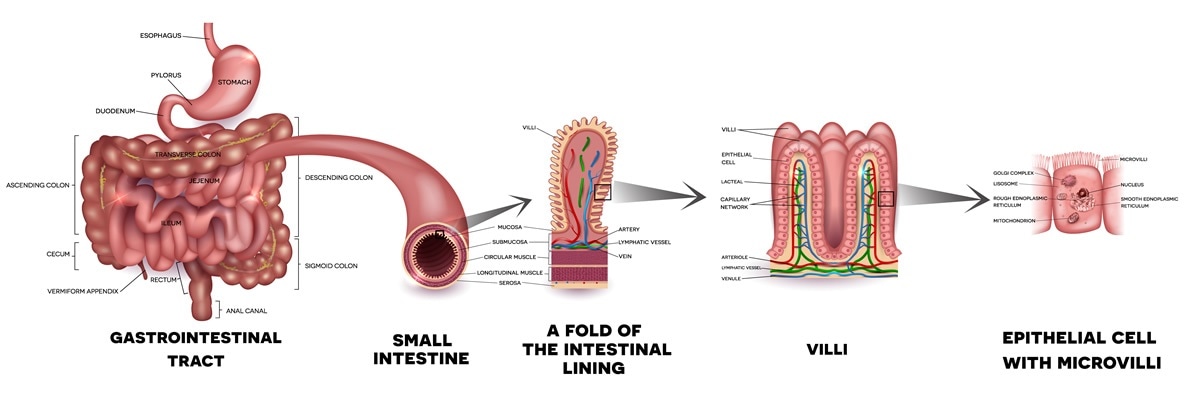Which Best Describes Food When It Reaches the Small Intestine
Absorption of Digested Food. B chief cells of the stomach.

Digestive System Processes Biology Ii
The blood carries the absorbed food material to different parts of the body.

. This enzyme enters the small intestine through the pancreatic duct and gets to work on deconstructing starch into smaller chains and individual molecules. The process by which digested food molecules are absorbed into the bloodstream and transported to different parts of the body is known as absorption. The proteins have been broken down.
It is referred to as the small intestine because its lumen opening is smaller in diameter at approximately 25 centimeters or 098 inches than the large intestine colon. Which best describes food when it reaches the stomach. Most of the nutrients have been removed.
Assessment Choose the letter of the correct answer. It has been broken down into small proteins. The nutrients are further broken down by secretions from organs.
By the time food has reached the small intestine it has been broken down into small proteins. The food that is digested is absorbed into the blood vessels in the walls of the intestine. The digested food molecules pass through the walls of the small intestine and then into the bloodstream.
When food now churned into a substance called chyme enters the small intestine the pancreas releases its own digestive enzymes to help break down starch says Frontiers in Nutritions research. When empty the mucosa of the stomach contains large folds called. The lowest part of your small intestine is the ileum.
E enteroendocrine cells of the duodenum. Recall that the colon is also home to the microflora called intestinal flora that aid in the digestion process. D acini of the pancreas.
The middle part of your small intestine is the jejunum. The absorptive epithelial cells of the small intestine are called enterocytes. Small Intestine It is where the final digestion of food takes place.
Which of the following best describes what happens to nutrients in the chyme as it travels through the small intestine. 1 See answer Advertisement Advertisement emmahalfhill is waiting for your help. The food enters into the small intestine from the stomach in which the digestion of proteins begins.
C parietal cells of the stomach. The nutrients have been removed. Cellulose digestion in ruminant mammals occurs before the ingested foods reach the small intestine E.
The small intestine is the main site for the digestion of chyme and absorption of the nutrients from the digested material. The polysaccharides have been broken down. Food begins its journey through the digestive system in the mouth before being pushed by a series of involuntary muscle contractions through the esophagus then the stomach and then the small and large intestines.
The final step in digestion is the elimination of undigested food content and waste products. A hepatic cells in the liver. The lower third portion of the small intestine about 12 feet long is called the ileum.
Large Intestine It stores the undigested food. It has been converted to urine. It has been completely digested.
Absorption of food begins with the small intestine. Water minerals saltsandvitaminsare also absorbed in the small intestineThe small intestine absorbs5-10 dm3of water each dayHow ever the colon absorbs much less water and salt than the small intestine generally around0305 dm3per day. This is where the final parts of digestive absorption take place.
Which best describes food when it reaches the stomach. Add your answer and earn points. Rectum It is where the food enters.
The finger-like projections known as villi drastically increase the surface area of the small intestine for greater absorption of the digested food. Different types of food are eaten by various groups of animals but it. The primary function of the small intestine is to break down.
In the stomach the enzyme pepsin acts on the peptide bonds of the protein and break it down into the smaller proteins. Free fatty acid absorption occurs in the small intestine. After food passes through the small intestine the undigested food material enters the colon where most of the water is reabsorbed.
In fact it is the longest portion of the digestive system approximately 20 to 25 feet in length. By the time food reaches the large intestine it has already been broken down into a substance called chyme by the stomach which has then had the nutrients absorbed from it by the small intestine. Then they are taken up by intestinal lining cells and digested further by intracellular enzymes.
Bile salts from the pancreas are essential to the digestion of fats. The polysaccharides have been broken down. The ileum absorbs bile acids fluid and vitamin B-12.
The first portion of the small intestine is called the duodenum. It has been converted to polysaccharides. Pepsinogen is produced by the.
The teeth of herbivores tend to be sharper than the teeth of carnivores The ruminants are front-end fermenters with mutualistic microbes residing in chambers or. The jejunum absorbs most of your nutrients. B chief cells of the stomach.
Carbohydrates fats minerals proteins and vitamins. Digested food molecules are small enough to pass through the wall of the intestine into the bloodstream. The middle portion of the small intestine which is approximately 8 feet long is called the jejunum.
The digestive system is essentially a series of long hollow organs lined with muscles that contract in a rhythmic pattern known as peristalsis to. Fats are fully digested after passage through the mouth and stomach. Which best describes food when it reaches the large intestine.
Write your answer on a separate sheet.
What Are The Correct Pathways Of Food In The Digestive System Quora

No comments for "Which Best Describes Food When It Reaches the Small Intestine"
Post a Comment